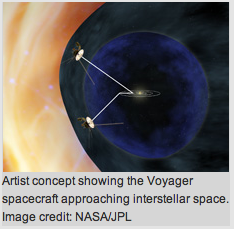 In this episode of NASA Now, you’ll meet aerospace engineer Aisha Bowe, who is helping NASA solve this complex problem. Learn why there is no perfectly designed system and all technological solutions have trade-offs, such as safety, cost or efficiency. Learn about the types of conflicts aircraft encounter and how engineers use trade-offs to come up with the best overall solution.
In this episode of NASA Now, you’ll meet aerospace engineer Aisha Bowe, who is helping NASA solve this complex problem. Learn why there is no perfectly designed system and all technological solutions have trade-offs, such as safety, cost or efficiency. Learn about the types of conflicts aircraft encounter and how engineers use trade-offs to come up with the best overall solution.
Link to the NES Virtual Campus home page.
NASA Now Minute: Air Traffic Management


 NASA’s Voyager spacecraft are hurtling towards the edge of our solar system, more than 10 billion miles away from our sun. Interstellar space – the medium between stars – is a region no human-made craft has ever been. On Apr. 28, 2011, a live NASA TV program will feature mission scientists discussing the distant areas Voyager 1 and 2 are exploring, 10 billion miles away from our sun.
NASA’s Voyager spacecraft are hurtling towards the edge of our solar system, more than 10 billion miles away from our sun. Interstellar space – the medium between stars – is a region no human-made craft has ever been. On Apr. 28, 2011, a live NASA TV program will feature mission scientists discussing the distant areas Voyager 1 and 2 are exploring, 10 billion miles away from our sun.  The Moderate Resolution Imaging Spectroradiometer, or MODIS, on NASA’s Aqua satellite and the MODIS sensor on NASA’s Terra satellite took photos of Japan’s earthquake and tsunami. Images were made with infrared and visible light to highlight the presence of water and other features on the ground.
The Moderate Resolution Imaging Spectroradiometer, or MODIS, on NASA’s Aqua satellite and the MODIS sensor on NASA’s Terra satellite took photos of Japan’s earthquake and tsunami. Images were made with infrared and visible light to highlight the presence of water and other features on the ground. Students and their families explored a variety of science stations. They looked through large telescopes set up by members of the Greater New Haven Astronomical Society; viewed lunar craters and the moons of Jupiter; and learned about constellations by viewing a planetarium show inside a portable planetarium.
Students and their families explored a variety of science stations. They looked through large telescopes set up by members of the Greater New Haven Astronomical Society; viewed lunar craters and the moons of Jupiter; and learned about constellations by viewing a planetarium show inside a portable planetarium.